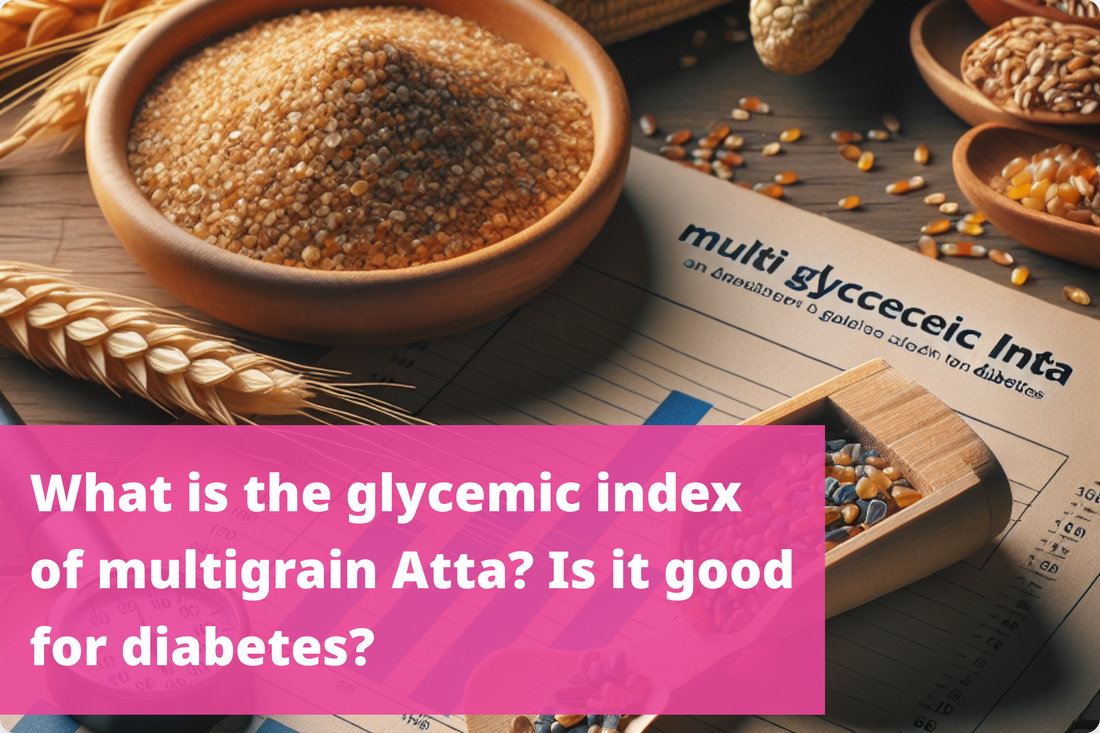Welcome to this exploration of the glycemic index and its impact on diabetes, with a specific focus on multigrain atta. The glycemic index, or GI, is a vital measure indicating how quickly a carbohydrate-containing food raises blood glucose levels. For those managing diabetes, understanding the glycemic index is crucial in making informed dietary choices.
Now, why the spotlight on multigrain atta? Well, atta, a staple in many households, plays a significant role in our diets, especially in the form of roti or chapati. As we delve into this topic, we aim to unravel the mysteries surrounding the glycemic index of multigrain atta and its implications for individuals with diabetes.
So, buckle up as we embark on a journey to demystify the glycemic index and explore whether multigrain atta can be a friend or foe for those navigating the nuances of diabetes management.
Understanding Glycemic Index
Let's break down the concept of the glycemic index (GI) to better grasp its significance. In simple terms, the GI is a numerical scale that measures how quickly carbohydrates in food affect blood sugar levels. The scale categorizes these foods into low, medium, and high GI, providing a guide to their impact on our blood glucose.
Low GI foods, with a score of 55 or less, are digested and absorbed slowly, causing a gradual rise in blood sugar. Medium GI foods, scoring between 56 and 69, lead to a moderate increase. Meanwhile, high GI foods, scoring 70 or above, prompt a rapid spike in blood sugar levels.
Understanding the GI is like having a roadmap for managing blood sugar. Opting for low GI foods can help regulate glucose levels, offering a steady and sustained release of energy. On the other hand, high GI foods can lead to rapid spikes, potentially causing challenges for those with diabetes.
Incorporating this knowledge into our dietary decisions empowers us to make choices that contribute to overall well-being, especially for individuals aiming to maintain stable blood sugar levels. So, as we navigate the realm of glycemic index, remember, it's not just about numbers; it's about making informed choices for a healthier lifestyle.
Atta and Its Varieties And How to Choose Right Multigrain Atta
Let's turn our attention to the kitchen staple – atta. Atta, a form of whole wheat flour, is a cornerstone of many Indian households, often finding its way into our daily meals, particularly in the preparation of roti or chapati.Multigrain atta takes the spotlight here, offering a blend of various grains, each contributing its unique nutritional profile. It's a versatile choice, potentially packing in more nutrients than its single-grain counterparts. This variety has gained popularity, especially among those seeking a wholesome dietary option.
1. Check the Ingredients:
Low-Glycemic Grains: Look for multigrain atta that includes grains with a low glycemic index, such as barley, ragi (finger millet), oats, jowar (sorghum), and bajra (pearl millet).
Whole Grains: Ensure the atta is made from whole grains rather than refined grains to maximize fiber and nutrient content.
Variety of Grains: A good multigrain atta will have a diverse mix of grains, providing a balanced nutritional profile.
2. Avoid Additives:
No Added Sugars: Check the label to ensure there are no added sugars, which can spike blood glucose levels.
Minimal Additives: Avoid products with unnecessary additives, preservatives, or artificial colors and flavors.
3. Nutritional Information:
High Fiber Content: Choose multigrain atta with a high fiber content, as fiber helps regulate blood sugar levels.
Protein Content: Higher protein content is beneficial for overall health and can help with satiety.
Low Sodium: Opt for products with low sodium levels to maintain overall health.
4. Quality and Brand Reputation:
Reputable Brands: Choose atta from well-known and reputable brands that follow quality standards.
Customer Reviews: Read customer reviews and feedback to understand the experiences of others with the product.
5. Packaging and Storage: Ensure the atta is well-sealed and packaged to maintain freshness and prevent contamination.
Interestingly, atta isn't confined to the traditional roti; it also plays a role in unexpected places. Take Maggi, for instance. The incorporation of atta in Maggi attests to its versatility and adaptability. It's not just a flour; it's a culinary companion in diverse recipes.The common use of atta in the Indian diet speaks to its cultural significance and nutritional value. Whether unleashing creativity in the kitchen with multigrain atta or sticking to the comforting roti, atta stands as a dietary cornerstone, weaving through the fabric of our daily meals. As we explore its variations, it's essential to understand how atta, in its many forms, contributes not only to taste but also to the nutritional richness of our diets.
Benefits of Multigrain Atta for Diabetes:
Now, let's dig into the heart of our discussion – the glycemic index of multigrain atta. Research has delved into understanding how this staple fares on the glycemic index scale and its implications for blood sugar levels.
Lower Glycemic Index: Combination of Grains: Multigrain atta typically includes grains like whole wheat, barley, ragi, oats, and millet, which have lower glycemic indices compared to refined flours. This helps in maintaining stable blood sugar levels.
High Fiber Content: Dietary Fiber: The inclusion of multiple whole grains increases the overall fiber content, which slows down the absorption of sugars and improves blood sugar control.
Nutrient-Dense: Vitamins and Minerals: Multigrain atta is rich in essential nutrients like B vitamins, iron, magnesium, calcium, and antioxidants, which support overall health and well-being.
Better Satiety: Prolonged Fullness: The higher fiber and protein content in multigrain atta can help keep you feeling full for longer periods, reducing the likelihood of overeating and helping in weight management, which is crucial for diabetes management.
Studies have shown that multigrain atta tends to have a lower glycemic index compared to refined flours. This is promising news for those concerned about blood sugar spikes, as low GI foods are associated with a slower, more controlled release of glucose.
When we compare multigrain atta with other types, like ragi atta, the nuances become apparent. Ragi, or finger millet, often praised for its nutritional content, typically has a lower glycemic index than traditional wheat atta. However, the multigrain blend brings its own set of benefits, offering a mix of grains that contribute to a more balanced nutritional profile.
Enter the concept of low glycemic index atta – a potential ally for those looking to manage their blood sugar levels. Choosing atta with a lower GI can be a strategic move, promoting better glycemic control and potentially reducing the risk of diabetes-related complications.
In essence, the glycemic index of multigrain atta paints a promising picture for those seeking a balance between tradition and health. As we navigate through the data and research, the aim is clear – to empower you with knowledge that enables informed decisions about the atta that graces your kitchen.
Is Multigrain Atta Good for Diabetes?
Let's tackle the burning question: Is multigrain atta a diabetes-friendly choice? The answer lies in a nuanced exploration of its potential benefits, drawbacks, and considerations for those managing diabetes.
Firstly, the potential benefits: Multigrain atta, with its lower glycemic index, holds promise for individuals with diabetes. Its slower impact on blood sugar levels suggests that it might be a more stable choice compared to refined flours. The mix of grains in multigrain atta also brings diverse nutrients to the table, contributing to a more balanced diet.
However, it's essential to consider the bigger picture. While multigrain atta may offer advantages, moderation is key. Portion control remains crucial, as even low GI foods can impact blood sugar levels if consumed excessively. Additionally, individual responses to different grains can vary, so it's wise to monitor how your body reacts.
Now, let's talk about atta roti – a dietary mainstay for many. The glycemic index of atta roti is influenced not only by the type of atta used but also by factors like thickness and cooking time. Opting for multigrain atta in your roti could be a positive move, but it's vital to consider overall meal composition and other dietary choices.
In conclusion, the suitability of multigrain atta for diabetes hinges on mindful consumption. While it can be part of a well-rounded, diabetes-conscious diet, it's crucial to maintain balance, monitor portions, and listen to your body's responses. As we navigate the landscape of dietary choices, let's remember that empowerment comes from knowledge and informed decision-making. If you are still skeptical about Multigrain atta’s ability to maintain your blood sugar levels, you can check out Diabesmart’s Diabetic Care Atta. Made for the sole purpose of introducing a flour with lowest glycemic index in the market, Diabesmart Atta is a choice you can opt for without thinking twice.
Multigrain Atta, the key to managing diabetes
In wrapping up our exploration, the spotlight on multigrain atta and its glycemic index offers valuable insights for those managing diabetes. Here's a quick recap:
Multigrain atta, with its lower glycemic index, presents a promising option for those aiming to stabilize blood sugar levels. Research indicates that this choice can contribute to better glycemic control compared to refined flours.
However, moderation is key. While multigrain atta brings nutritional diversity to the table, it's crucial to be mindful of portion sizes. Even low GI foods can impact blood sugar levels if consumed excessively. Personal responses to different grains also vary, reinforcing the importance of attentive self-monitoring.
For those who swear by atta roti, the type of atta matters. Opting for multigrain atta in your roti can be a positive step, but the overall composition of your meals and portion control remain critical factors.
As we navigate the landscape of dietary choices, remember that informed decisions are the pillars of health-conscious living. The journey to managing diabetes isn't a one-size-fits-all approach, and the role of multigrain atta is just one piece of the puzzle.
In conclusion, empower yourself with knowledge, be mindful of your body's responses, and craft a diet that aligns with your health needs. Multigrain atta, with its potential benefits, invites you to make choices that contribute not only to managing diabetes but also to overall well-being. Cheers to informed decisions and a healthier, happier you!
This Blog post is an initiative by DiabeSmart, to provide accurate and Nutritionist / Doctor approved information related to Diabetes. DiabeSmart is India's first Food brand designed specifically for Diabetics, that has been clinically tested on Diabetics and Pre-Diabetics to deliver 55% - 70% lower Sugar spikes. DiabeSmart is part of Lo! Foods - India's leading brand for Everyday Functional Health foods.













